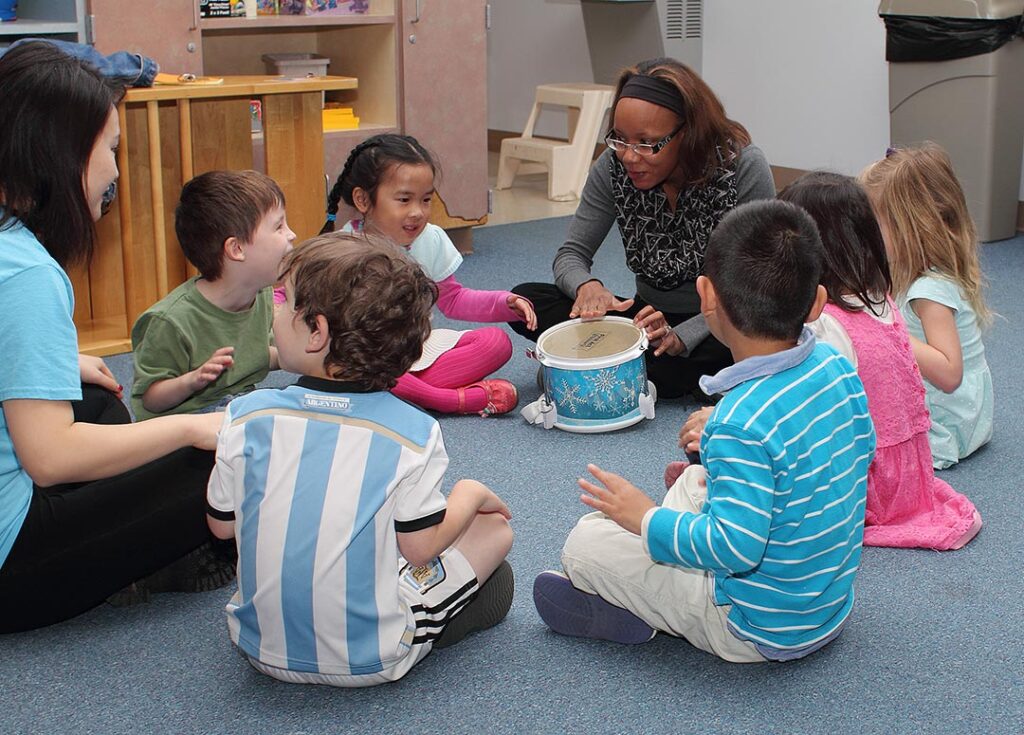
The ELM Curriculum fully recognizes that early childhood program staff have diverse educational backgrounds and professional experiences. A majority of staff in early childhood programs nationally do not have a bachelor’s degree. Staff turnover rates are relatively high. At the same time, many educators have four-year college degrees and important early childhood teaching experiences.
ELM Curriculum resources are designed for a range of staff backgrounds. Consider the model of high-quality implementation offered in ELM activity plans. The example provides a clear illustration of strong practices that may be new information to less experienced staff members. For experienced staff members, the implementation example offers practice ideas – such as child-friendly definitions of new words – to consider in relation to established approaches. Staff with years of experience may benefit from the ELM Curriculum’s up-do-date information on how to promote child skills that recent research shows are critically important. These areas include self-regulation, math, and aspects of literacy and language.
Programs that use the ELM Curriculum appreciate its solid base. There is respect for the influence of standards established by the National Association for the Education of Young Children (NAEYC) on the curriculum’s content and methods. Crosswalks are available for how NAEYC’s accreditation standards and assessment items are represented in the ELM Curriculum’s resources for infants and toddlers (click here) and children 3-5 years of age (click here).
In addition to activity plans, NAEYC’s position statement on developmentally appropriate practice and program accreditation requirements are part of ELM’s online training lessons. A lesson on Making the Most of Activity Plans, for example, invites staff to reflect on the NAEYC developmentally appropriate practice statement that classroom staff need flexibility in carrying out planned experiences for children in their room.

Programs also respect how the content and methods of the ELM Curriculum were driven by results of in-depth reviews of rigorous research focused on two questions:
Findings identified in response to the first question were used to determine foundation skills promoted in the ELM Curriculum. There are 14 foundation skills for infants and toddlers, and 27 foundation skills for preschool-age children.
Studies of effective practices in early childhood programs informed the scope, sequence, and details of ELM’s activity plans. Examples include the proven use of yoga and breathing exercises to promote self-regulation, and multiple ways to help children learn letters and numbers.
Programs can use the ELM Curriculum with assurances that its approach is consistent with the early learning expectations of prominent organizations. This website includes infant-toddler (click here) and preschool-age (click here) crosswalks that align the ELM Curriculum with the Head Start Program’s Early Learning Outcomes Framework and with a sampling of states where ELM is being implemented.

Programs that use the ELM Curriculum value its tools for helping staff tailor children’s learning experiences:
Scaffolding tips in each activity plan that help staff offer more support or increase the challenge of a learning experience
Activity options that differ in developmental levels and skill understanding
What to Look For sections in all infant-toddler activity plans that suggest how to respond to different types of child participation
Guides for Observing and Individualizing progress in foundation skills promoted by ELM, including ideas for follow-up learning supports
Progress Assessments of preschool-age children’s literacy skills and counting skills, each with ideas for follow-up learning activities
The ELM Curriculum’s resources are flexibly connected by a clear focus on the foundation skills promoted by the curriculum. Each activity plan is devoted to an aspect of a foundation skill. The Readiness Starts Early parenting tips extend the activity to families. Each child observation and assessment tool is similarly focused on a specific foundation skill or component of a skill. User Guides, training lessons, and forthcoming videos are in supportive roles, centered on helping staff members use ELM resources toward the optimal development of each child.
Classroom staff and managers of programs using ELM describe many benefits of the curriculum. Here are some:
“Families were considering pulling their child from the center to send to a public school pre-k. After attending the ELM open house and seeing the sample lessons, they chose to leave their child at our center. The parents loved the approach and how it can be adapted to each child’s interests and skill level.”
“We have a seasoned staff member who is and has been burned out. It has been a constant, unsuccessful battle to have her do anything but sit and watch the children. She [recently] did an ELM preschool lesson and can’t say enough good things about it. She said it’s easy, the children enjoy it, and she loves that she can teach the children. She is like a new person.”
“This is the second year that our children have been in the ELM preschool program. During the mid-year assessment in January, we had two children score at a 1st grade level, two at mid-kindergarten level, and two at a beginning of the year kindergarten level.”
“The ELM curriculum supports all areas in children’s development. It is easy to follow and implement. The staff that do not have any background in ECE or experience working with children can easily implement it in their classrooms. It reduces stress and extra thought and time they have to put into thinking about different activities they have to plan in all areas of growth. It gives them time to make relationships and connections with children in the program who are the most important part of our world.”
“ELM activity plans remove the guesswork from creating activities that directly correlated with children’s learning. It’s exciting for both the children and teachers to witness growth and development driven by these well-structured plans.”
“Classrooms have seen significant improvements in social-emotional and self-regulation skills as well as the seamless integration of math and literacy development into children’s play…. Both preschool families and professionals (are) confident that ELM has equipped children with the skills needed for kindergarten readiness, ensuring a strong foundation for future learning.”
“It has been rewarding to guide each child at their current skill level and support their progression to the next. Families have noticed significant growth in their children, particularly in language development, often commenting on the noticeable impact of ELM at home and the increased love for books.”
“ELM enables us to better address each child’s needs, whether related to language development or social-emotional growth. It also provides both new and seasoned caregivers with fresh ideas, topics, and resources, all within a single comprehensive package.”
“The ELM Curriculum provides a framework for intentionally teaching social-emotional and self-regulation skills, leading to notable growth in peer interactions and children’s ability to identify emotions in themselves and others.”
“I was looking for an inexpensive curriculum that helped me teach the whole child (as a family child care provider). ELM has helped me with this. I see the difference in each child. They love to tell me about each book we read. I see their independence and how they share their emotions before they let them get out of hand. The children’s parents have seen their child’s improvement in all areas….
The curriculum has helped me be a better teacher. I also have learned a lot. I find this curriculum and teaching so much fun.
…I wholeheartedly believe that I got a 4 star rating in the Texas Rising Star by incorporating ELM in my child care. The back and forth conversations that I have with the children are awesome.”
Click here to watch and listen to a panel of child development professionals whose programs are implementing the ELM Curriculum. They are from the Air Force, Marine Corps, Defense Logistics Agency, and Purdue University. They offered their views of ELM during a virtual session organized by the U.S. Department of Defense and Purdue University to introduce the ELM Curriculum to leaders of national organizations focused on early education and care.